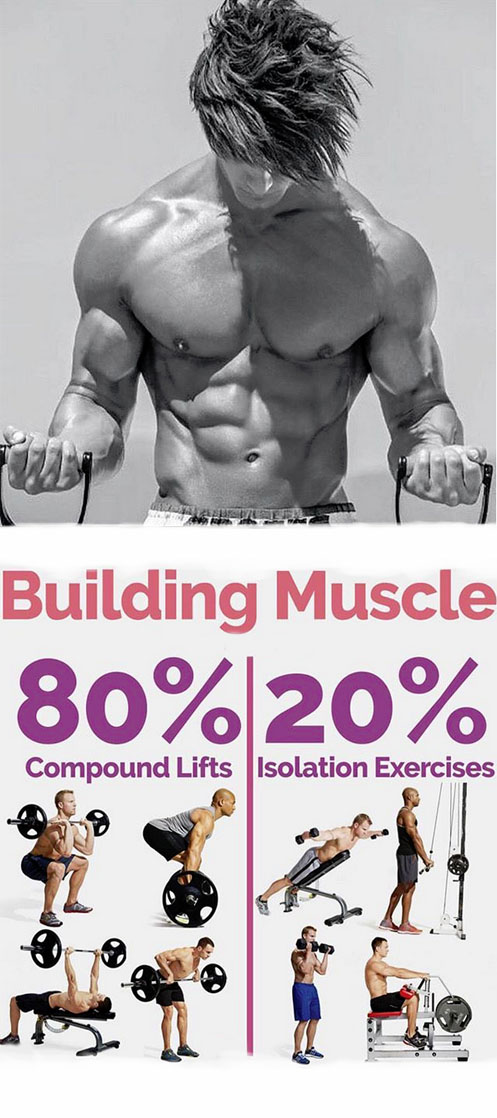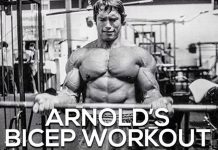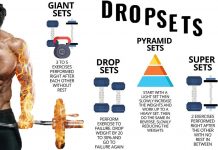Hello friends. Today is a very important topic that will answer the frequently asked question: why do not my muscles grow.
Which I will consider in terms of not the right type of training. Since I am insanely broken this morning thinking something difficult intellectual, I’ll take a ready-made article from my future book “The Body on Reconstruction”, cut it down a bit, explain a little and put it all on your bright heads.
Postulate: The type of strength training can be DIFFERENT.
[wp_ad_camp_1]
I think no one will argue with this. It is enough to see how the powerlifter, the bodybuilder and the weightlifter are training to make sure of this. One works with very large scales and a lot of rest, the other works with lighter weights but resting a little, and the third works with ridiculous weights, but does not rest at all! TYPE OF TRAINING is different, because everyone has different goals!
And the principle of SPECIFICITY in sports says: WHAT WE TRANING, THEN WE GET OUT! If you need the maximum POWER, then you need to train the maximum muscle power in one repetition. If you need muscular endurance, then you need to train a quick energy resynthesis. Well, if you need a MUSCULAR MASS, you need something in between. But let’s start in order. What is the growth of muscle mass in principle?
GROWTH of muscle mass, is one of the types of adaptation of our body to the power load. When external conditions violate the established equilibrium (the internal environment is the external environment), our body is forced to change, in order to restore this balance, by adapting to the new external conditions. In our case, the external conditions are training with iron. They change the balance and force the body to ADAPT to them by the growth of various indicators. Such as:
- energy (glycogen stores, etc.)
- Nervous communication (motor units, etc.)
- Efficiency of muscle contraction (the consistency of the work of muscles and myofibrils inside the muscles, muscle coordination, etc.)
- The size of the muscle fiber (the number of myofibrils and their size inside)
[wp_ad_camp_1]
Have noticed that the growth of muscle I put at the very end? The fact is that this type of adaptation comes in the last turn, only when it is impossible to “solve the problem” with easier adaptations. Because MUSCLE GROWTH is the most energy-consuming adaptation and is least beneficial to our body.
So what is MUSCLE GROWTH?
This is an increase in muscle strength by increasing the size and amount of contractile muscle structures (muscle cells), in the first place. And an increase in the energy and support structures of the muscle (sarcoplasm), in the second turn. Experienced trainers in bodybuilding say: for maximum muscle growth, it is necessary to combine together: myofibrillar hypertrophy + sarcoplasmic hypertrophy.
As we have already understood, hypertrophy is the growth of muscles or adaptation to external conditions. If these conditions CONSTANTLY change (become tougher), it forces our muscles to constantly adapt to them. That is why the PROGRESS of loads is fundamentally important. There is a progression, then the external conditions are constantly changing, then there is a CONSTANT muscle growth. There is no progression … it means that it is not profitable for our muscles to progress (change their size).
Here we come to the most delicious. The progression of loads in force training can occur in a million different ways. And some of these ways will force the muscles to grow better than others.
[wp_ad_camp_4]
How can PROGRESS the load:
An increase in WEIGHT on the rod (the most popular method, because the simplest, this method grows well muscular strength)
Increase the volume of the workout (make more approaches and exercises, ie increase the work capacity of the muscles)
Increase in the lose of ENERGY during the approach (you can do more repetitions, cheating, droppings, etc. This method improves muscular endurance)
The mistake of many is that they do not train correctly in terms of choosing the way the load progresses. Man simply chose the wrong type of strength training for maximum muscle growth.
Remember a very important moment, about which almost no one ever talks.
The main feature of the big muscles is the HIGH POWER OPERATIONALITY!
- Powerlifters have high power.
- At the weightwell or crossfitter – high power endurance
- A bodybuilder has a high power capacity
Also, the next important feature is universality. Muscles, in order to become large, must be able to show in addition to working capacity is not a bad force and not bad endurance. That is why, ideally, for the growth of large muscles, a different load of BUTs is needed, with an emphasis on training great working capacity.
If your goal is LARGE MUSCLE, then your training should contain LARGE QUANTITA OF APPROACHES AND EXERCISES (large volume of training).
[wp_ad_camp_1]
The difficulty lies in the fact that you need to consider a lot of other factors.
If the training is too voluminous, the damage can be greater than the subsequent growth.
If the training is too small (in volume), then the damage will be too little for the subsequent muscle growth.
The volume of training directly depends on the weight of the weight in each approach!
IT CAN BE EFFICIENT, LONGERED, OR TIGHTEN. BUT IT CAN NOT BE HEAVY + LONG TIME!
Heavy weights train strength in pure form (at one time). This is their plus and minus. We need strength, because it is for the generation of greater strength that muscle fibers thicken. On the other hand, we do not need strength training, because it lengthens the rest between the approaches (the efficiency falls). Where is the way out? Exit in the middle. There must be an alternative: the weights are heavy enough to deplete the power, but light enough to be able to recover to the next approach quickly: in 1-2 minutes.
Or another alternative: PERIODIZATION. When we alternate heavy workouts for strength (great rest between approaches) with medium workouts for work ability (less rest between approaches).

[wp_ad_camp_4]
HARD TRAINING.
The concept is more than relative. Especially when the intensity of training means its intensity. A person can work with very heavy weights, but rest 5-10 minutes between sets. Either another example, a person can work with light weights, but do approach after approach every 20-30 seconds of rest. Which one of them is heavier (more intense) training?
In my opinion, nature agrees with me, the most “hard training” in CULTURALISM, because we force our muscles to work (adapt) at once in several ways:
- with heavy weights (strength training)
- little rest between the approaches (this is the endurance already)
- We make many approaches with heavy weights (this is workability)
Why did I say that nature agrees with me? And do you remember what adaptation nature (our body) will go to last? ON MUSCLE GROWTH, because this is the most complex and expensive adaptation. And the law of conservation of energy tells us that it’s just that it does not happen! For every minus its plus! Therefore, the most significant increases in muscles will be for the heaviest workouts (for the most important adaptations)! The same obvious things. Moreover, our subconscious understands this perfectly. That’s why we envy a man with big muscles. Somewhere in the back of our minds, we understand that big muscles just do not happen like that. They say that this man is superbly adapted for long-term power work. And this is better in us.
The severity of training (intensity) can be divided into three large groups.
High Intensive Training (HIT), Medium Intensive Training (MIT) and Low Intensive Training (LIT).
HIT 75-100% (heavy weights)
MIT 50-75% (Medium weight)
LIT 20-50% (light weights)
the heavier the weight, the more you have to rest between the approaches and the less the intensity of such training.
The shorter the rest between approaches, the easier the weight we have to use.
Bodybuilding, where in the middle. BUT, mind, the bodybuilder trains ALL! Just Medium Intensive Training (MIT) in its program is more than HIT and LIT!
Why HIT is not the best option for big muscles?
Because in training with very large weights there is a “failure” (inability to continue the approach), which is not due to the depletion of the energy reserves of the muscle, but due to the failure of the central nervous system + a slight drop in energy!
The energy of muscle contractions is fundamentally important for the growth of large muscles. With prolonged muscular work (6-12 repetitions), you “force” your muscles to adapt to the lacks of energy by resynthesis (glycolysis) in large quantities. During this chemical reaction of energy resynthesis, a number of anabolic factors (sex hormones, hydrogen ions, etc.) that trigger the growth of your muscles are produced.
With short muscular work (repetition at times with maximum power), you DO NOT consume the energy reserves in muscles DEEPLY. In fact, glycolysis does not have time to turn on, because you are spending a “one-time supply” (creatine phosphate, according to Loman’s reaction). So there is no resynthesis of energy and there is no development of anabolic factors …
How soon you stop your approach on a straight line depends on the weight of the barbell. If this weight is very large (HIT), then you can do 1-5 repetitions. And this for serious muscle growth will be small. It is necessary to do from 6 repetitions.
Why LIT is not the best option for big muscles?
Again the main reason is energy. Always think about it. The energy in our body is like money in world politics and economics. Find who is profitable and you will understand the essence! So with too light scales (many repetitions), energy consumption goes in smaller portions and longer. As a result, it is advantageous for the body to use a more economical way of resynthesis of energy by oxidizing nutrients, instead of glycolysis, which is “useful” for muscle growth. Therefore, doing many repetitions (15-20 or more …) is not the best option if your goal is to maximize muscle growth.
When do muscles grow best?

[wp_ad_camp_1]
Muscles grow best when you deplete the energy reserves before the effective ways of its cheap resynthesis are turned on to the full.
- Early stop work (big weight) and … there will be no depleted energy
- Late stop the work (small weight) and … switch on another way of power supply.
- Optimum – in the middle (6-12 repetitions, weight of medium gravity). And this, as you understand and there is a Medium Intensive Training aimed at developing muscular efficiency.
[wp_ad_camp_1]
These are simple truths that are intuitively understood by all experienced bodybuilders. Why do these schemes NOT help beginners? Two reasons:
or they are not yet ready for such a large volume of loads (do too many approaches and repetitions, without preparing the body at once).
or train long and hard at the same time
One follows from the other. And in the end … “plateau” or overtraining. Muscles naturally do not grow because the body is not up to it. The body eliminates the worst damage. What is there to grow?
Therefore, never copy the schemes of professionals. In order to work on these schemes professionals for decades have prepared (adapted) all the systems of their body. You do not even think of compete with deep-sea divers for pearls, when you swim in the pool. So why are you trying to replicate what a professional bodybuilder can do in the gym?
The most reasonable will be a very gradual increase in the load from the most insignificant in order to understand where your limit.
Even more reasonable will be the alternation of different trainings in order to develop in all directions and maintain health. This is what we will adhere to during our training in order to get the maximum result.



















































